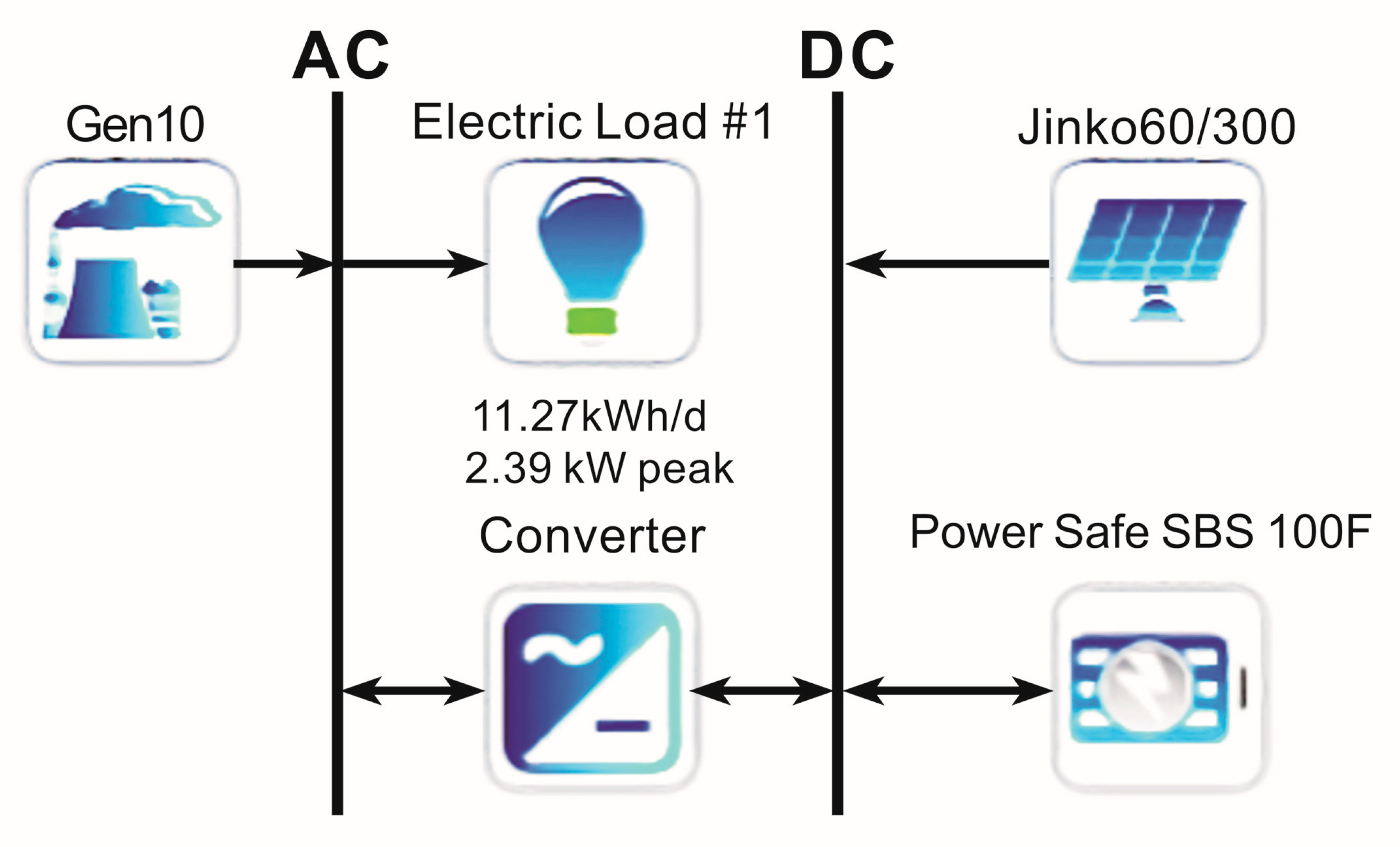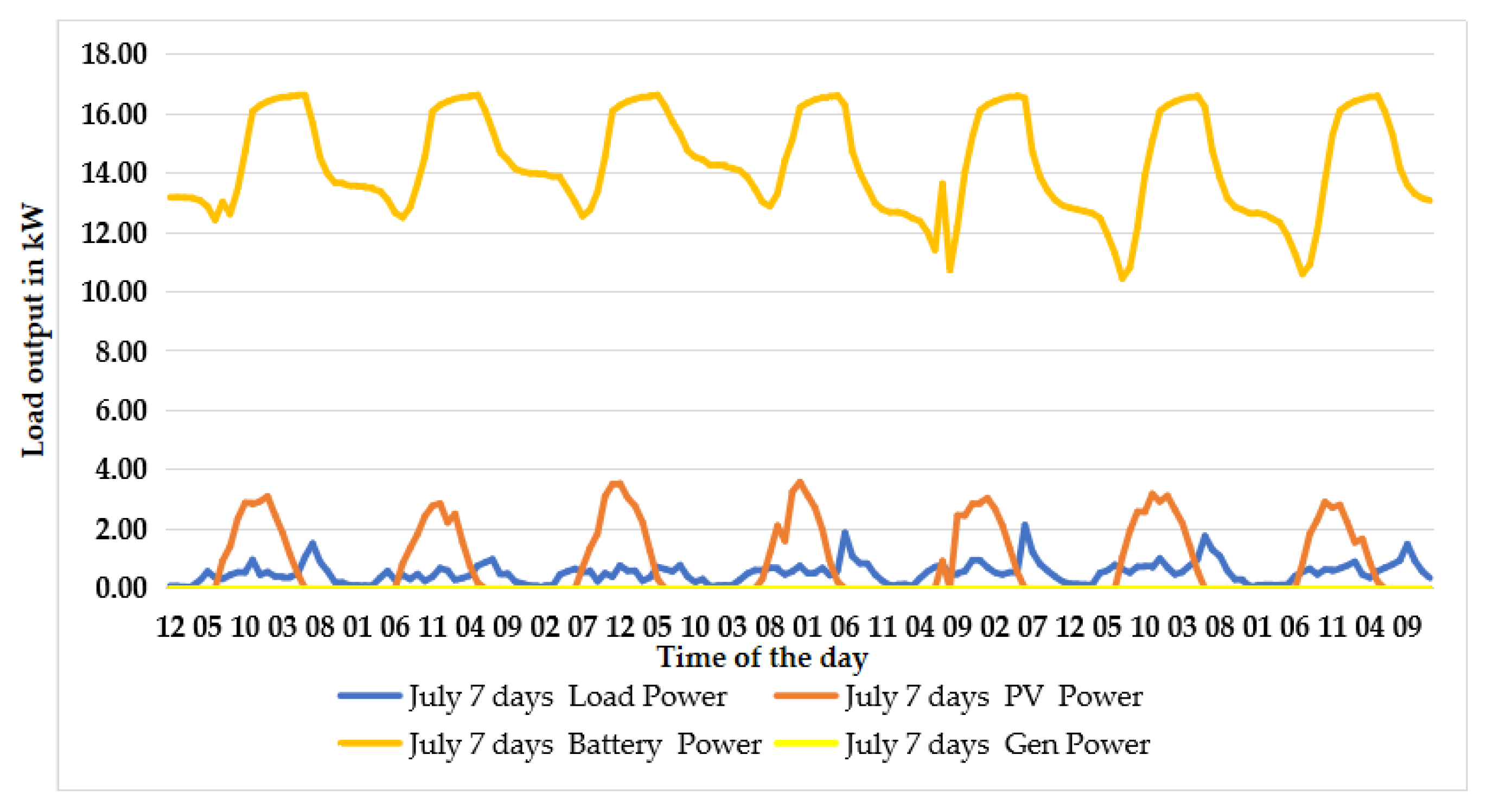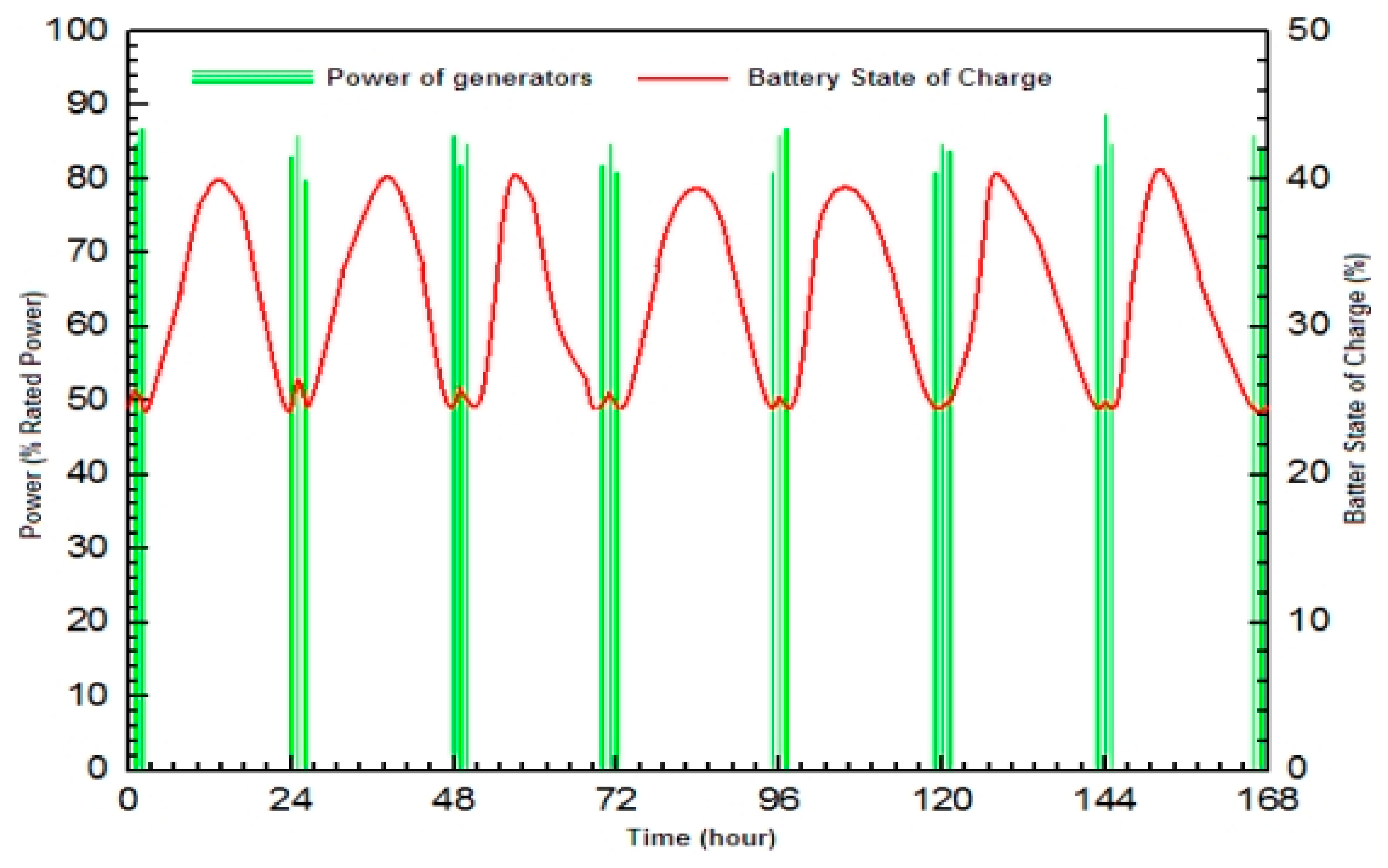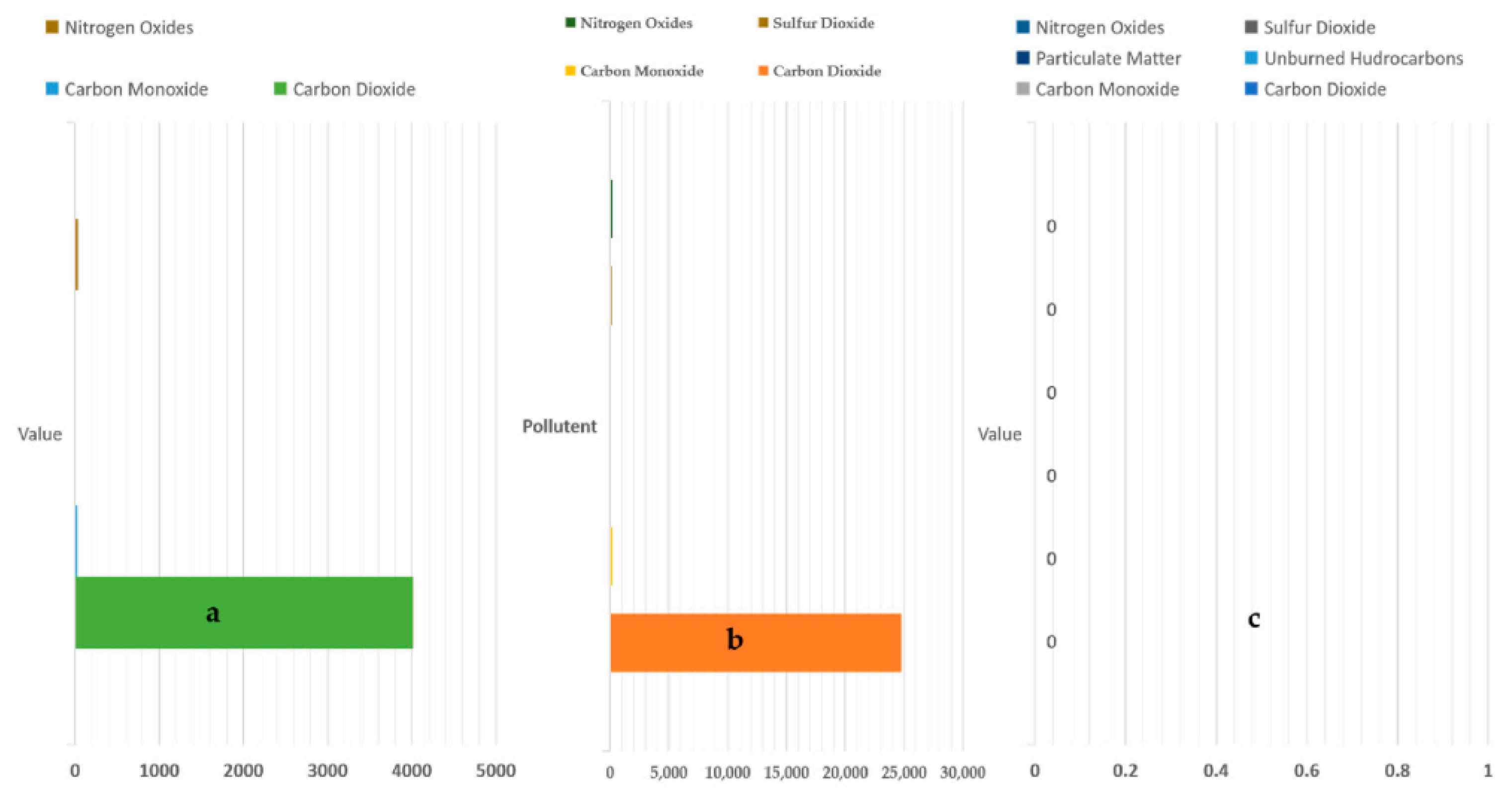A Hybrid Photovoltaic/Diesel System for Off-Grid Applications in Lubumbashi, DR Congo: A HOMER Pro Modeling and Optimization Study
Abstract
1. Introduction
The Need for Renewable Energy in Developing Countries
2. Methodology
2.1. The Homer Pro Software
2.2. Input Data and Assumptions Used in the Analyses
2.3. Simulation of Each Scenario
2.4. Further Analysis of the Outputs
2.5. Levelized Cost of Energy
2.6. Emissions
2.7. Modeling and Simulating the Hybrid Diesel–PV Power System
2.8. Input Parameters
3. Results and Discussion
3.1. Technical Performance of the Hybrid Diesel–PV Power System
3.2. Economic Analysis of the System, including Costs and Savings
3.3. Emissions
4. Conclusions
Author Contributions
Funding
Institutional Review Board Statement
Informed Consent Statement
Data Availability Statement
Acknowledgments
Conflicts of Interest
References
- Mohammad Rozali, N.E.; Wan Alwi, S.R.; Abdul Manan, Z.; Klemeš, J.J.; Hassan, M.Y. Process Integration of Hybrid Power Systems with Energy Losses Considerations. Energy 2013, 55, 38–45. [Google Scholar] [CrossRef]
- Oviroh, P.O.; Jen, T.C. The Energy Cost Analysis of Hybrid Systems and Diesel Generators in Powering Selected Base Transceiver Station Locations in Nigeria. Energies 2018, 11, 687. [Google Scholar] [CrossRef]
- Tsuanyo, D.; Azoumah, Y.; Aussel, D.; Neveu, P. Modeling and Optimization of Batteryless Hybrid PV (Photovoltaic)/Diesel Systems for off-Grid Applications. Energy 2015, 86, 152–163. [Google Scholar] [CrossRef]
- Alotaibi, M.A.; Salama, M.M.A. An Incentive-Based Multistage Expansion Planning Model for Smart Distribution Systems. IEEE Trans. Power Syst. 2018, 33, 5469–5485. [Google Scholar] [CrossRef]
- Abi Ghanem, D.; Mander, S. Designing Consumer Engagement with the Smart Grids of the Future: Bringing Active Demand Technology to Everyday Life. Technol. Anal. Strat. Manag. 2014, 26, 1163–1175. [Google Scholar] [CrossRef]
- Charfi, S.; Atieh, A.; Chaabene, M. Modeling and Cost Analysis for Different PV/Battery/Diesel Operating Options Driving a Load in Tunisia, Jordan and KSA. Sustain. Cities Soc. 2016, 25, 49–56. [Google Scholar] [CrossRef]
- Agarwal, N.; Kumar, A. Varun Optimization of Grid Independent Hybrid PV–Diesel–Battery System for Power Generation in Remote Villages of Uttar Pradesh, India. Energy Sustain. Dev. 2013, 17, 210–219. [Google Scholar] [CrossRef]
- Malheiro, A.; Castro, P.M.; Lima, R.M.; Estanqueiro, A. Integrated Sizing and Scheduling of Wind/PV/Diesel/Battery Isolated Systems. Renew Energy 2015, 83, 646–657. [Google Scholar] [CrossRef]
- Yap, W.K.; Karri, V. An Off-Grid Hybrid PV/Diesel Model as a Planning and Design Tool, Incorporating Dynamic and ANN Modelling Techniques. Renew Energy 2015, 78, 42–50. [Google Scholar] [CrossRef]
- Basheer, Y.; Waqar, A.; Qaisar, S.M.; Ahmed, T.; Ullah, N.; Alotaibi, S. Analyzing the Prospect of Hybrid Energy in the Cement Industry of Pakistan, Using HOMER Pro. Sustainability 2022, 14, 12440. [Google Scholar] [CrossRef]
- Alsharif, M.H. Techno-Economic Evaluation of a Stand-Alone Power System Based on Solar Power/Batteries for Global System for Mobile Communications Base Stations. Energies 2017, 10, 392. [Google Scholar] [CrossRef]
- Zailan, R.; Zaini, S.N.; Mohd Rashid, M.I.; Abdul Razak, A. Feasibility Study of Standalone PV-Wind-Diesel Energy Systems for Coastal Residential Application in Pekan, Pahang. MATEC Web Conf. 2017, 131, 2001. [Google Scholar] [CrossRef]
- Mohamed, A.M.A.; Al-Habaibeh, A.; Abdo, H. An Investigation into the Current Utilisation and Prospective of Renewable Energy Resources and Technologies in Libya. Renew Energy 2013, 50, 732–740. [Google Scholar] [CrossRef]
- Wang, Q.; Jiang, X.T.; Yang, X.; Ge, S. Comparative Analysis of Drivers of Energy Consumption in China, the USA and India—A Perspective from Stratified Heterogeneity. Sci. Total Environ. 2020, 698, 134117. [Google Scholar] [CrossRef]
- Strielkowski, W.; Sherstobitova, A.; Rovny, P.; Evteeva, T. Increasing Energy Efficiency and Modernization of Energy Systems in Russia: A Review. Energies 2021, 14, 3164. [Google Scholar] [CrossRef]
- Tang, C.F.; Tiwari, A.K.; Shahbaz, M. Dynamic Inter-Relationships among Tourism, Economic Growth and Energy Consumption in India. Geosystem Eng. 2016, 19, 158–169. [Google Scholar] [CrossRef]
- Bhattacharya, M.; Paramati, S.R.; Ozturk, I.; Bhattacharya, S. The Effect of Renewable Energy Consumption on Economic Growth: Evidence from Top 38 Countries. Appl. Energy 2016, 162, 733–741. [Google Scholar] [CrossRef]
- Alsharif, M.H. Comparative Analysis of Solar-Powered Base Stations for Green Mobile Networks. Energy 2017, 10, 1208. [Google Scholar] [CrossRef]
- Kalogirou, S. Solar Energy Engineering: Processes and Systems, 2nd ed.; Elsevier: Amsterdam, The Netherlands, 2009. [Google Scholar]
- Lamulamu, A.; Ploton, P.; Birigazzi, L.; Xu, L.; Saatchi, S.; Kibambe Lubamba, J.P. Assessing the Predictive Power of Democratic Republic of Congo’s National Spaceborne Biomass Map over Independent Test Samples. Remote. Sens. 2022, 14, 4126. [Google Scholar] [CrossRef]
- Papazis, S.A. Integrated Economic Optimization of Hybrid Thermosolar Concentrating System Based on Exact Mathematical Method. Energies 2022, 15, 7019. [Google Scholar] [CrossRef]
- Erdinc, O.; Uzunoglu, M. Optimum Design of Hybrid Renewable Energy Systems: Overview of Different Approaches. Renew. Sustain. Energy Rev. 2012, 16, 1412–1425. [Google Scholar] [CrossRef]
- Sinha, S.; Chandel, S.S. Review of Software Tools for Hybrid Renewable Energy Systems. Renew. Sustain. Energy Rev. 2014, 32, 192–205. [Google Scholar] [CrossRef]
- Iñigo-Labairu, J.; Dersch, J.; Schomaker, L. Integration of CSP and PV Power Plants: Investigations about Synergies by Close Coupling. Energies 2022, 15, 7103. [Google Scholar] [CrossRef]
- Ajlan, A.; Tan, C.W.; Abdilahi, A.M. Assessment of Environmental and Economic Perspectives for Renewable-Based Hybrid Power System in Yemen. Renew. Sustain. Energy Rev. 2017, 75, 559–570. [Google Scholar] [CrossRef]
- Veerashekar, K.; Askan, H.; Luther, M. Qualitative and Quantitative Transient Stability Assessment of Stand-Alone Hybrid Microgrids in a Cluster Environment. Energies 2020, 13, 1286. [Google Scholar] [CrossRef]
- Lu, Y.; Wang, Q.; Zhang, X.; Qian, Y.; Qian, X. China’s Black Carbon Emission from Fossil Fuel Consumption in 2015, 2020, and 2030. Atmos Env. 2019, 212, 201–207. [Google Scholar] [CrossRef]
- Mukhtaruddin, R.N.S.R.; Rahman, H.A.; Hassan, M.Y. Economic Analysis of Grid-Connected Hybrid Photovoltaic-Wind System in Malaysia. In Proceedings of the 4th International Conference on Clean Electrical Power: Renewable Energy Resources Impact, ICCEP 2013, Alghero, Italy, 11–13 June 2013; pp. 577–583. [Google Scholar] [CrossRef]
- Khan, M.J.; Yadav, A.K.; Mathew, L. Techno Economic Feasibility Analysis of Different Combinations of PV-Wind-Diesel-Battery Hybrid System for Telecommunication Applications in Different Cities of Punjab, India. Renew. Sustain. Energy Rev. 2017, 76, 577–607. [Google Scholar] [CrossRef]
- Adaramola, M.S.; Paul, S.S.; Oyewola, O.M. Assessment of Decentralized Hybrid PV Solar-Diesel Power System for Applications in Northern Part of Nigeria. Energy Sustain. Dev. 2014, 19, 72–82. [Google Scholar] [CrossRef]
- Vaka, M.; Walvekar, R.; Rasheed, A.K.; Khalid, M. A Review on Malaysia’s Solar Energy Pathway towards Carbon-Neutral Malaysia beyond COVID-19 Pandemic. J. Clean Prod. 2020, 273, 122834. [Google Scholar] [CrossRef]
- Silva, A.R.; Estanqueiro, A. From Wind to Hybrid: A Contribution to the Optimal Design of Utility-Scale Hybrid Power Plants. Energies 2022, 15, 2560. [Google Scholar] [CrossRef]
- Albani, A.; Ibrahim, M.Z.; Taib, C.M.I.C.; Azlina, A.A. The Optimal Generation Cost-Based Tariff Rates for Onshore Wind Energy in Malaysia. Energies 2017, 10, 1114. [Google Scholar] [CrossRef]
- Sukarno, K.; Hamid, A.S.A.; Jackson, C.H.W.; Pien, C.F.; Dayou, J. Comparison of Power Output Between Fixed and Perpendicular Solar Photovoltaic PV Panel in Tropical Climate Region. Adv. Sci. Lett. 2017, 23, 1259–1263. [Google Scholar] [CrossRef]
- Abdulmula, A.; Sopian, K.; Ludin, N.A.; Haw, L.C.; Elberki, A.; Aldawi, F.; Moria, H. Micropower System Optimization for the Telecommunication Towers Based on Various Renewable Energy Sources. Int. J. Electr. Comput. Eng. 2022, 12, 1069–1076. [Google Scholar] [CrossRef]
- Alsharif, M.H. A Solar Energy Solution for Sustainable Third Generation Mobile Networks. Energies 2017, 10, 429. [Google Scholar] [CrossRef]
- Odoi-Yorke, F.; Woenagnon, A. Techno-Economic Assessment of Solar PV/Fuel Cell Hybrid Power System for Telecom Base Stations in Ghana. Cogent Eng. 2021, 8. [Google Scholar] [CrossRef]
- HOMER Energy. HOMER®Pro Version 3.7-User Manual; HOMER Energy: Boulder, CO, USA, 2016. [Google Scholar]





| Configuration | Investment Analysis | References |
|---|---|---|
| The optimal layouts with the lowest net present cost (NPC) and cost of energy (COE) are (FPV + b) followed by HP + b. The NPC and COE costs of FPV + b and HP + b are 17.45%, 16.45%, 15.9%, and 15.5% lower than those of diesel generators with a battery (DG + b), respectively. | [31] |
| The PV technology achieved the best option as it has the lowest initial cost per kW of USD 1150/kW, an LCOE of USD 0.051/kW, and a simple payback period of 18.6 years. | [10] |
| The most cost-effective scenario is a hydrogen-battery hybrid energy storage system. It revealed that it has the lowest NPC and COE over the 25-year project lifespan. In comparison to a battery-based storage system, it uses less excess energy. | [38] |
| The design of PV/diesel with a battery system is the recommended solution. The system’s initial capital cost and total NPC are USD 2,260,000 and USD 16,661,344, respectively. The COE of the system is USD 0.377/kW. The design can save 14.3% of diesel fuel consumption, and a carbon footprint can be saved. The most expensive design in electricity generation is diesel-only, while the second most expensive is hybrid diesel–PV without a battery system. | [30] |
| PV/diesel with a battery system configuration is the ideal recommended hybrid system. The system’s initial capital cost and total NPC are USD 8336.13 and USD 5794.18, respectively. With a levelized COE of USD 0.1090/kW. Under the given local climate condition, the diesel generator can remain unused throughout the whole year (0% of fuel consumption). This hybrid system can emit lower to no emissions all year round compared to other configurations. | Current study |
| Scenario | System Configuration | Limitations |
|---|---|---|
| PV provides the required energy to the power system and stores excess energy in the battery for the night and low radiation use. The generator starts only at the start of the complete discharge of the battery and has absolutely no solar radiation resource. | PV Battery Diesel Generator | Within the HOMER Pro system, the scenario for the selected location of DR Congo has the diesel generator out of work due to the vast available solar radiation on a daily basis and in all seasons. |
| Diesel generator only. In this scenario, power is fully provided by the diesel generator, which is used to make the comparison with the first scenario. | 10 Kva Diesel Generator | HOMER assumes that the diesel generator is on 24/7 throughout the whole year. This configuration gives a perspective that all diesel Gen owners emit the same amount of CO2 daily and simultaneously. |
| System Component | Capacity (kW/Unit) | Capital Cost, USD | Replacement Cost (USD) | Maintenance Cost |
|---|---|---|---|---|
| Diesel | 10 | 1000 | 400 | 20 |
| Battery | 1 | 81.80 | 81.80 | 0 |
| Solar PV | 0.3 | 82.75 | 30 | 5 |
| Converter | 3 | 439 | 300 | 0 |
| Configuration | LCOE (USD) | Load (kW/d) |
|---|---|---|
| Diesel–PV–Battery | 0.11 | 11.27 |
| PV–Battery | 0.89 | 11.27 |
| Time of the Day | Load Power (kW) | PV Power (kW) | Battery Power (kW) | Gen Power (kW) |
|---|---|---|---|---|
| 1 | 0.06 | 0 | 0.05 | 0 |
| 2 | 0.09 | 0 | 0.1 | 0 |
| 3 | 0.12 | 0 | 0.16 | 0 |
| 4 | 0.4 | 0 | 0.24 | 0 |
| 5 | 0.59 | 0 | 0.52 | 0 |
| 6 | 0.48 | 0.08 | 0.93 | 0 |
| 7 | 0.42 | 0.2 | 1.21 | 0 |
| 8 | 0.36 | 0.28 | 1.37 | 0 |
| 9 | 0.42 | 0.45 | 1.43 | 0 |
| 10 | 0.4 | 0.05 | 1.41 | 0 |
| 11 | 0.55 | 0.02 | 1.66 | 0 |
| 12 | 0.69 | 0.38 | 2.03 | 0 |
| 13 | 0.48 | 0.33 | 2.25 | 0 |
| 14 | 0.35 | 0.12 | 2.37 | 0 |
| 15 | 0.21 | 0.06 | 2.53 | 0 |
| 16 | 0.36 | 0.17 | 2.62 | 0 |
| 17 | 0.46 | 0.1 | 2.75 | 0 |
| 18 | 1.06 | 0.06 | 3.03 | 0 |
| 19 | 0.91 | 0 | 3.71 | 0 |
| 20 | 0.66 | 0 | 4.34 | 0 |
| 21 | 0.49 | 0 | 4.8 | 0 |
| 22 | 0.22 | 0 | 5.13 | 0 |
| 23 | 0.17 | 0 | 5.26 | 0 |
| 24 | 0.08 | 0 | 5.32 | 0 |
| Mean | 10.03 | 2.3 | 55.22 |
| Production | Quantity (kW/yr) | Unit (%) |
|---|---|---|
| PV system | 7331 | 100 |
| Diesel gen | 0 | 0 |
| AC primary load | 4113 | 100 |
| DC primary load | 0 | 0 |
| Deferrable load | 0 | 0 |
| Excess electricity | 2939 | 40.1 |
| Unmet electric load | 0 | 0 |
| Capacity shortage | 0 | 0 |
| Renewable fraction | 100 | |
| Max. Renew. Penetration | 2013 |
Disclaimer/Publisher’s Note: The statements, opinions and data contained in all publications are solely those of the individual author(s) and contributor(s) and not of MDPI and/or the editor(s). MDPI and/or the editor(s) disclaim responsibility for any injury to people or property resulting from any ideas, methods, instructions or products referred to in the content. |
© 2023 by the authors. Licensee MDPI, Basel, Switzerland. This article is an open access article distributed under the terms and conditions of the Creative Commons Attribution (CC BY) license (https://creativecommons.org/licenses/by/4.0/).
Share and Cite
Rice, I.K.; Zhu, H.; Zhang, C.; Tapa, A.R. A Hybrid Photovoltaic/Diesel System for Off-Grid Applications in Lubumbashi, DR Congo: A HOMER Pro Modeling and Optimization Study. Sustainability 2023, 15, 8162. https://doi.org/10.3390/su15108162
Rice IK, Zhu H, Zhang C, Tapa AR. A Hybrid Photovoltaic/Diesel System for Off-Grid Applications in Lubumbashi, DR Congo: A HOMER Pro Modeling and Optimization Study. Sustainability. 2023; 15(10):8162. https://doi.org/10.3390/su15108162
Chicago/Turabian StyleRice, Ilunga Kajila, Hanhua Zhu, Cunquan Zhang, and Arnauld Robert Tapa. 2023. "A Hybrid Photovoltaic/Diesel System for Off-Grid Applications in Lubumbashi, DR Congo: A HOMER Pro Modeling and Optimization Study" Sustainability 15, no. 10: 8162. https://doi.org/10.3390/su15108162
APA StyleRice, I. K., Zhu, H., Zhang, C., & Tapa, A. R. (2023). A Hybrid Photovoltaic/Diesel System for Off-Grid Applications in Lubumbashi, DR Congo: A HOMER Pro Modeling and Optimization Study. Sustainability, 15(10), 8162. https://doi.org/10.3390/su15108162







